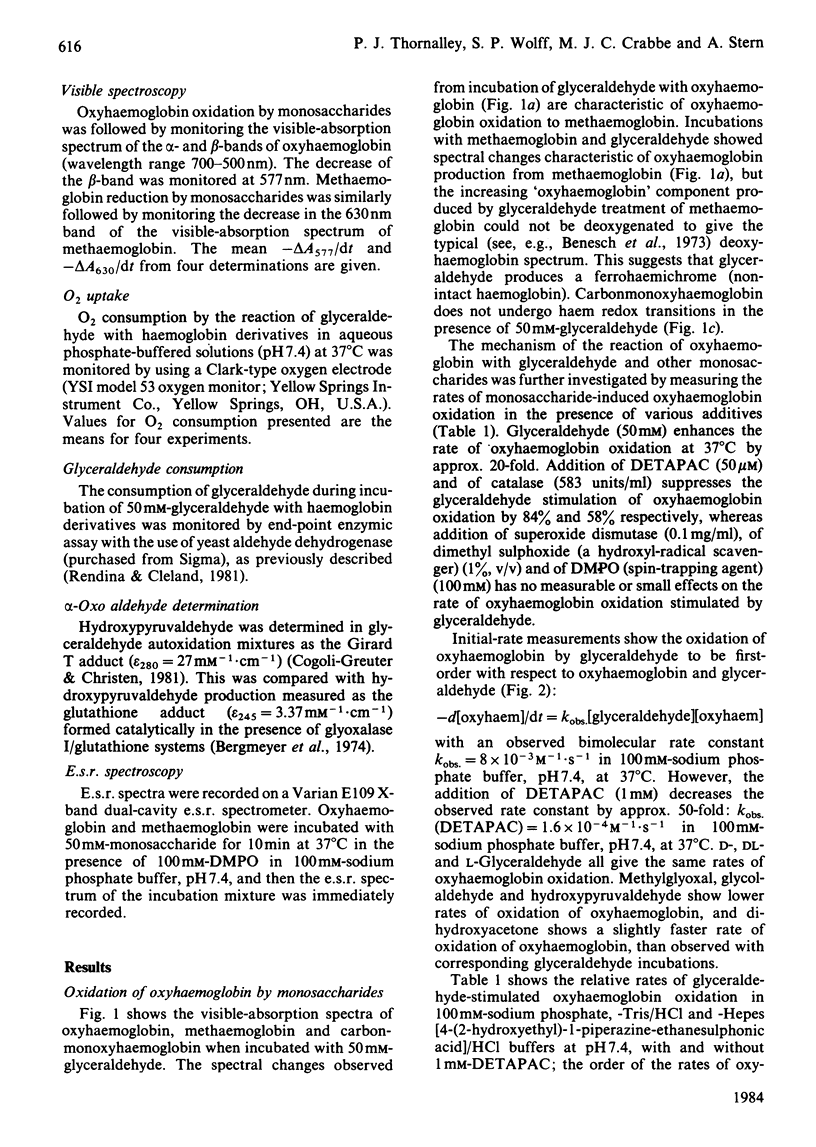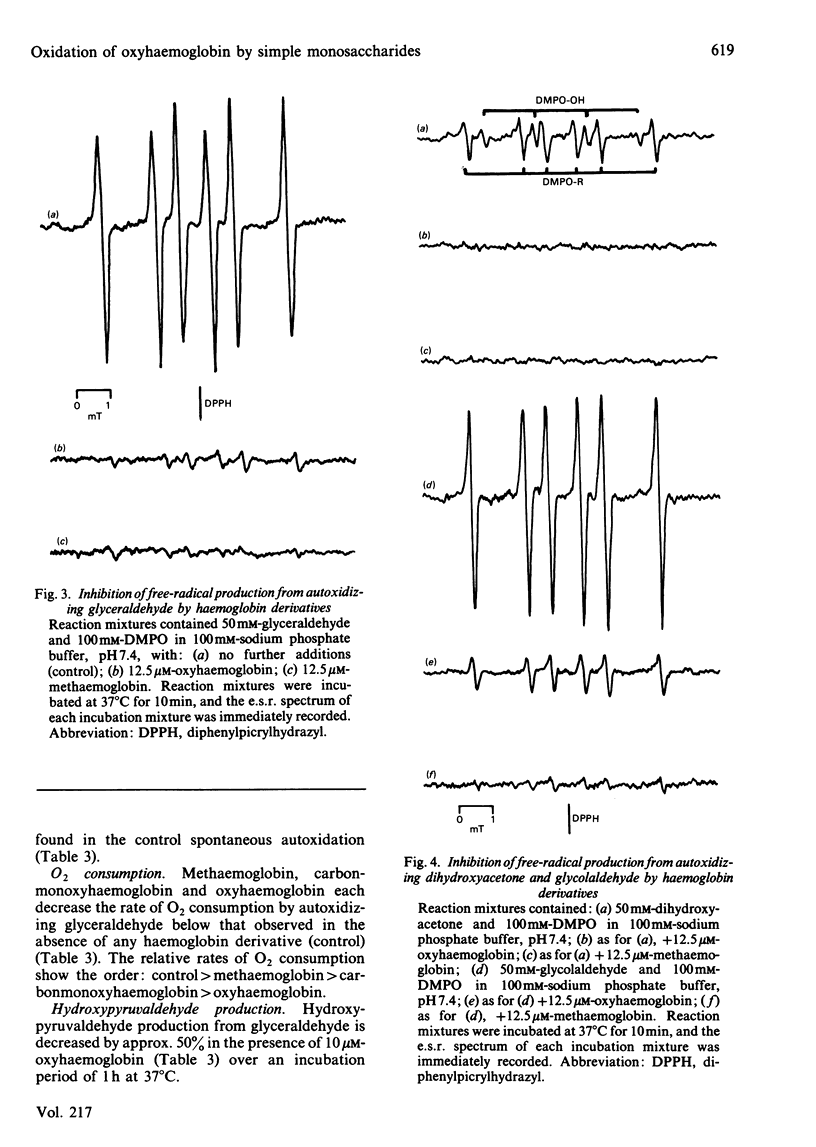Abstract
Glyceraldehyde and other simple monosaccharides oxidize oxyhaemoglobin to methaemoglobin in phosphate buffer at pH 7.4 and 37 degrees C, with the concomitant production of H2O2 and an alpha-oxo aldehyde derivative of the monosaccharide. Simple monosaccharides also reduce methaemoglobin to ferrohaemichromes (non-intact haemoglobin) at pH 7.4 and 37 degrees C. Carbonmonoxyhaemoglobin is unreactive towards oxidation by autoxidizing glyceraldehyde. Free-radical production from autoxidizing monosaccharides with haemoglobins was observed by the e.s.r. technique of spin trapping with the spin trap 5,5-dimethyl-l-pyrroline N-oxide. Hydroxyl and l-hydroxyalkyl radical production observed from monosaccharide autoxidation was quenched in the presence of oxyhaemoglobin and methaemoglobin. The haemoglobins appear to quench the free radicals by reaction with the free radicals and/or the ene-diol precursor of the free radical.
Full text
PDF







Selected References
These references are in PubMed. This may not be the complete list of references from this article.
- ANTONINI E., BRUNORI M., WYMAN J. STUDIES ON THE OXIDATION-REDUCTION POTENTIALS OF HEME PROTEINS. IV. THE KINETICS OF OXIDATION OF HEMOGLOBIN AND MYOGLOBIN BY FERRICYANIDE. Biochemistry. 1965 Mar;4:545–551. doi: 10.1021/bi00879a026. [DOI] [PubMed] [Google Scholar]
- Acharya A. S., Manning J. M. Reactivity of the amino groups of carbonmonoxyhemoglobin S with glyceraldehyde. J Biol Chem. 1980 Feb 25;255(4):1406–1412. [PubMed] [Google Scholar]
- Benesch R. E., Benesch R., Yung S. Equations for the spectrophotometric analysis of hemoglobin mixtures. Anal Biochem. 1973 Sep;55(1):245–248. doi: 10.1016/0003-2697(73)90309-6. [DOI] [PubMed] [Google Scholar]
- Buettner G. R., Oberley L. W. Considerations in the spin trapping of superoxide and hydroxyl radical in aqueous systems using 5,5-dimethyl-1-pyrroline-1-oxide. Biochem Biophys Res Commun. 1978 Jul 14;83(1):69–74. doi: 10.1016/0006-291x(78)90398-4. [DOI] [PubMed] [Google Scholar]
- Castro C. E., Wade R. S., Belser N. O. Conversion of oxyhemoglobin to methemoglobin by organic and inorganic reductants. Biochemistry. 1978 Jan 24;17(2):225–231. doi: 10.1021/bi00595a005. [DOI] [PubMed] [Google Scholar]
- Cogoli-Greuter M., Christen P. Formation of hydroxypyruvaldehyde phosphate in human erythrocytes. J Biol Chem. 1981 Jun 10;256(11):5708–5711. [PubMed] [Google Scholar]
- Goldberg B., Stern A. Production of superoxide anion during the oxidation of hemoglobin by menadione. Biochim Biophys Acta. 1976 Jul 21;437(2):628–632. doi: 10.1016/0304-4165(76)90029-5. [DOI] [PubMed] [Google Scholar]
- Goldberg B., Stern A. The mechanism of oxidative hemolysis produced by phenylhydrazine. Mol Pharmacol. 1977 Sep;13(5):832–839. [PubMed] [Google Scholar]
- Goldberg B., Stern A. The role of the superoxide anion as a toxic species in the erythrocyte. Arch Biochem Biophys. 1977 Jan 15;178(1):218–225. doi: 10.1016/0003-9861(77)90187-4. [DOI] [PubMed] [Google Scholar]
- HENNESSEY M. A., WALTERSDORPH A. M., HUENNEKENS F. M., GABRIO B. W. Erythrocyte metabolism. VI. Separation of erythrocyte enzymes from hemoglobin. J Clin Invest. 1962 Jun;41:1257–1262. doi: 10.1172/JCI104588. [DOI] [PMC free article] [PubMed] [Google Scholar]
- Hill H. A., Thornalley P. J. Phenyl radical production during the oxidation of phenylhydrazine and in phenylphydrazine-induced haemolysis. FEBS Lett. 1981 Mar 23;125(2):235–238. doi: 10.1016/0014-5793(81)80727-2. [DOI] [PubMed] [Google Scholar]
- Nichol A. W., Hendry I., Morell D. B. Mechanism of formation of sulphhaemoglobin. Biochim Biophys Acta. 1968 Feb 1;156(1):97–108. doi: 10.1016/0304-4165(68)90108-6. [DOI] [PubMed] [Google Scholar]
- Nigen A. M., Manning J. M. Effects of glyceraldehyde on the structural and functional properties of sickle erythrocytes. J Clin Invest. 1978 Jan;61(1):11–19. doi: 10.1172/JCI108909. [DOI] [PMC free article] [PubMed] [Google Scholar]
- REEVES H. C., AJL S. J. ENZYMATIC SYNTHESIS AND METABOLISM OF HYDROXYPYRUVIC ALDEHYDE. J Biol Chem. 1965 Feb;240:569–573. [PubMed] [Google Scholar]
- Rendina A. R., Cleland W. W. Separation of aldehydes and ketones by chromatography on Dowex-50 in the ethylenediamine form. Anal Biochem. 1981 Oct;117(1):213–218. doi: 10.1016/0003-2697(81)90713-2. [DOI] [PubMed] [Google Scholar]
- Thornalley P. J., Trotta R. J., Stern A. Free radical involvement in the oxidative phenomena induced by tert-butyl hydroperoxide in erythrocytes. Biochim Biophys Acta. 1983 Aug 23;759(1-2):16–22. doi: 10.1016/0304-4165(83)90183-6. [DOI] [PubMed] [Google Scholar]
- Trotta R. J., Sullivan S. G., Stern A. Lipid peroxidation and hemoglobin degradation in red blood cells exposed to t-butyl hydroperoxide. Dependence on glucose metabolism and hemoglobin status. Biochim Biophys Acta. 1981 Dec 4;678(2):230–237. doi: 10.1016/0304-4165(81)90211-7. [DOI] [PubMed] [Google Scholar]


